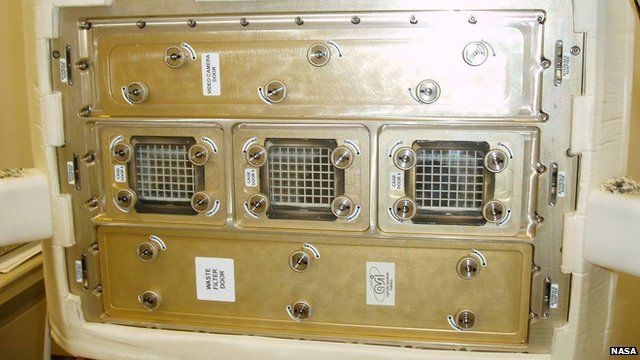Mice in space develop thin skin
- Published

A study of three mice that spent 91 days on the International Space Station has found abnormalities in their skin.
This is a record stay for any animal in space; due to their short lifespan it equates to about seven "mouse years".
The study is one of 20 experiments looking at various parts of the mice to measure the health effects of zero-g.
Using microscopes, scientists found the "astromice" had thinner skin than mice that had stayed on the ground, as well as changes to their muscles and hair.
The findings appear in the new journal NPJ Microgravity. Researchers say they are only preliminary, because of the very small sample size of three mice. But the observations are of interest because astronauts often report skin problems after long periods in space.
"If these were experiments on Earth, it would never have been accepted for publication because we had only three mice - but this is a unique experiment," said Dr Betty Nusgens from the University of Liege in Belgium, one of the study's authors.
She said it was difficult to extrapolate the findings to humans, but noted that other research had looked at human astronauts.
Astronauts tend to experience increased skin irritation and find that minor wounds, such as scratches and abrasions, take longer to heal.
The mouse experiments were planned to look at these skin changes in microscopic detail.
Thinning skin
Six mice were delivered to the ISS in August 2009 by the Discovery shuttle, in a specially built "Mouse Drawer System". This box, which held the mice in separate, secure cages, was installed on the space station for three months before returning to earth on the Atlantis shuttle in November.
The mice were fed and watered automatically and watched over by the ISS astronauts.
Three of the creatures survived the trip - the others falling victim to mishap or health complaints - and after landing, their various tissues and organs were collected by scientists involved in the 20 different studies.
Dr Nusgens and her colleagues got to work on three precious, small skin samples, which they compared with samples from three mice kept in a replica drawer system back on the ground, for the same period of time.
The outer skin layer of the space mice was thinner than that of the earth-bound control mice. There were also changes to the hair follicles.
"Hair grows and then stops growing - they rest and then they fall, this is the cycle," Dr Nusgens explained. "The cycle of the hair [in the space mice] was disturbed."
In particular, their hairs were in the opposite stage of the cycle from where they should have been - actively growing instead of resting.
"But we don't know how or why - we have no more experimental data to explain this problem," Dr Nusgens told BBC News.
Furthermore, this observation is less applicable to human astronauts, because our skin is only hairy in small sections.
Similarly, there were some changes to the layer of muscle lying directly under the skin - which is absent in humans.
"The main finding is that the skin of the mice that spent three months on the ISS became thinner than the control mice remaining on the ground," Dr Nusgens said.
Long time no 'g'
Dr David Green is a senior lecturer in aerospace physiology at King's College London. He told the BBC that these experiments were particularly noteworthy because of their duration: never before has a non-human animal spent this long in zero-g.
"Ninety-one days for a mouse corresponds to about seven years for a human," Dr Green said.
And although the study is only small, it emphasises that skin health is "highly relevant" to human spaceflight, especially as we look towards longer missions such as manned flights to Mars.
"It suggests that the skin is sensitive to being in microgravity, and that over long periods of time that might create a dysregulation in the proliferation and the replacement of skin.
"One of the interesting things about skin is that we're constantly replacing it. Of course, the top layer is dead skin cells - but actually it's a highly active organ."
Follow Jonathan on Twitter
- Published31 March 2015
- Published17 March 2014
- Published16 December 2012
- Published6 July 2012
- Published29 May 2012